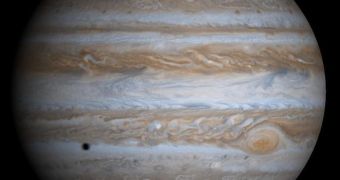Since the Sun first formed, about 4.6 billion years ago, the planets in our solar system have been shifting their positions non-stop. At this time, the trend is less obvious, but in the earliest days gas giants such as Jupiter ran wild. Now, a study looks at how the planet influences the solar system.
Jupiter is the largest planet orbiting the Sun. During the early days of the solar system, it used to move around a lot, traveling further inwards towards the star closer than Mars is today. In fact, the gas giant is responsible for the fact that the Red Planet experienced a stop in its growth.
The planet also exerted a considerable influence on the Inner Asteroid Belt, which orbits the Sun between the orbits of Mars and Jupiter. However, discovering such instances is a very complex issue, since these effects can only be inferred based on extremely-detailed studies.
In order to explain the reasons why Jupiter migrated early on in its history, as well as the effects that this migration had, investigators recently published details of a new computer model they set up.
The paper appears in the July 14 issue of the top scientific journal Nature. Experts behind the work say that they created a computer model of the early solar system with the express purpose of better understanding how the planet's movements shaped the current configuration of the system.
According to first author Kevin Walsh, the planet originally formed about 3.5 astronomical units (AU) from the Sun. At this point, it can be found 5+ AU from the star. An astronomical units is the average distance between the Earth and the Sun, the equivalent of 93 million miles (157 million kilometers).
Shortly after it formed, the gas giant started moving towards the inner solar system, reaching an orbit now occupied by Mars. At that time, the Red Planet hadn't formed yet. “We theorize that Jupiter stopped migrating toward the sun because of Saturn,” paper coauthor Avi Mandell proposes.
Both planets moved inward, but at one point their migration stopped, and both started moving further out. While Jupiter entered a stable orbit at 5 AU, Saturn moved to a more distant, intermediary one, at 7 AU. Eventually, it moved even further away, to its current orbit, some 9.5 AU from the Sun.
“Jupiter’s migration process was slow, so when it neared the asteroid belt, it was not a violent collision but more of a do-si-do, with Jupiter deflecting the objects and essentially switching places with the asteroid belt,” Mandell explains, quoted by Universe Today.
“With the [new] Grand Tack model, we actually set out to explain the formation of a small Mars, and in doing so, we had to account for the asteroid belt,” Walsh goes on to say.
“To our surprise, the model’s explanation of the asteroid belt became one of the nicest results and helps us understand that region better than we did before,” he concludes.

 14 DAY TRIAL //
14 DAY TRIAL //